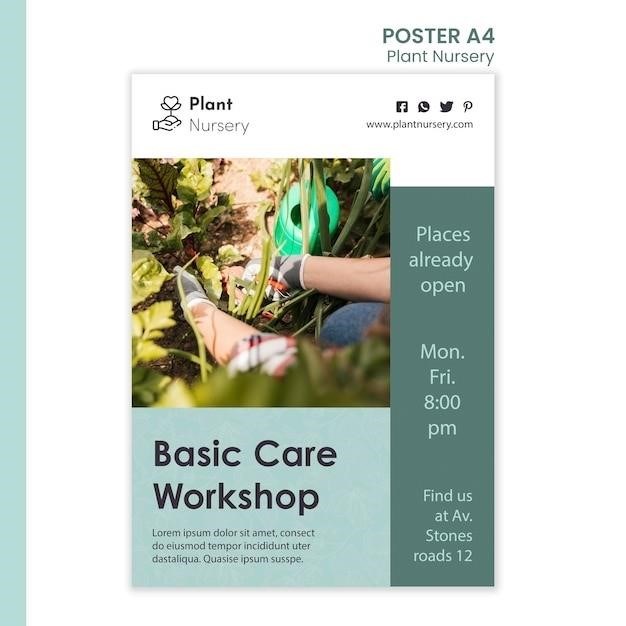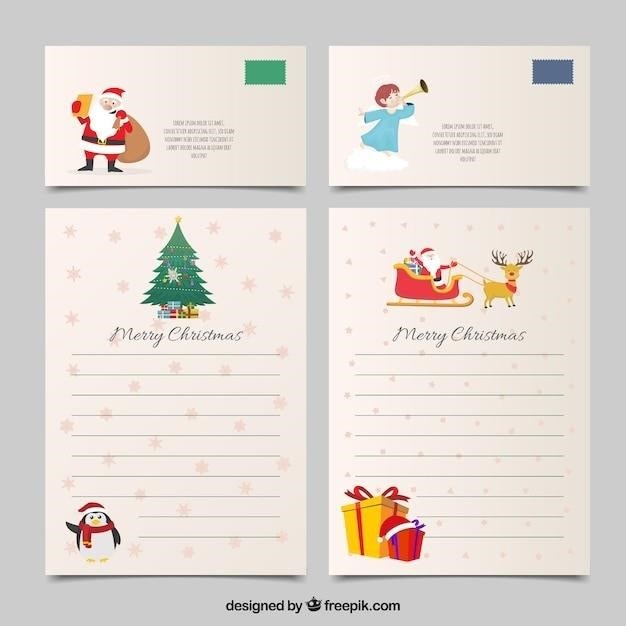This manual provides instructions on how to operate and program the Honeywell RTH2300B programmable thermostat, which is compatible with gas, oil, or electric furnaces, central air conditioners, and hot water systems․ It covers features, programming, energy saving settings, troubleshooting, and warranty information․
Introduction
Welcome to the world of comfortable and energy-efficient climate control with your new Honeywell RTH2300B programmable thermostat․ This manual is your guide to unlocking the full potential of your thermostat, helping you optimize your home’s temperature settings for ultimate comfort and cost savings․ Whether you’re a seasoned homeowner or a first-time user, this manual will walk you through every step, from basic operation to advanced programming features․
We encourage you to take the time to read through this manual carefully, as it contains essential information that will help you get the most out of your RTH2300B․ From setting the time and day to customizing program schedules, you’ll learn how to personalize your thermostat to match your lifestyle and optimize your home’s energy efficiency․
About Your New Thermostat
The Honeywell RTH2300B is a programmable thermostat designed for simplicity and convenience․ It features a user-friendly interface with clear, easy-to-read digital displays, allowing you to adjust heating and cooling settings with ease․ The RTH2300B offers a range of features to help you control your home’s temperature, save energy, and optimize your comfort․
One of the key benefits of this thermostat is its programmable feature, which allows you to set different temperature settings for various times of the day and days of the week․ This enables you to create customized schedules that align with your lifestyle and minimize energy consumption․ The RTH2300B also incorporates energy-saving settings to help you reduce your heating and cooling costs․
With its intuitive design and advanced features, the RTH2300B provides a convenient and efficient way to manage your home’s climate, ensuring both comfort and savings․
Features
The Honeywell RTH2300B offers a variety of features designed to enhance comfort, efficiency, and control over your home’s climate․ Its key features include⁚
- Backlit display⁚ The RTH2300B features a backlit display, providing clear visibility of temperature settings and system status even in low-light conditions․
- Ambient temperature display⁚ The display continuously shows the current ambient (measured) temperature, giving you a real-time indication of the room’s temperature․
- One-touch setpoint adjustment⁚ Easily adjust the desired temperature with a single button press, providing quick and convenient temperature control․
- Preset program settings⁚ The thermostat comes with pre-programmed schedules, offering a starting point for energy-saving settings․ You can customize these schedules to suit your preferences․
- Temporary and permanent schedule overrides⁚ The RTH2300B allows you to temporarily or permanently override the programmed schedule, giving you flexibility to adjust the temperature as needed․
- Built-in compressor protection⁚ This feature helps safeguard your air conditioning or heat pump system by preventing the compressor from restarting too soon after shutdown, reducing the risk of damage․
These features combine to provide a user-friendly and efficient thermostat experience․
Quick Reference to Controls
The Honeywell RTH2300B thermostat features a straightforward control panel, making it easy to navigate and adjust settings․ Here’s a quick reference to the controls⁚
- SET⁚ This button is used to set the time, day, and program schedules․ Press SET once to access the clock settings, twice to select the day, and three times to access the program schedules․ Holding down the SET button allows you to override the programmed temperature settings․
- Hold⁚ Pressing and holding the Hold button allows you to temporarily adjust the temperature for the current time period․ The Hold feature turns off the program schedule and allows you to manually control the thermostat․
- Run⁚ Pressing the Run button resumes the programmed schedule after a temporary override;
- Temperature adjustment buttons⁚ Use these buttons to increase or decrease the desired temperature, whether you are setting the temperature manually or adjusting the programmed settings․
- SYSTEM switch⁚ This switch allows you to select the desired system setting, choosing between Heat, Cool, or Off․ This switch controls your heating or cooling system, depending on the season․
- FAN switch⁚ The FAN switch allows you to select between Auto and On modes․ In Auto mode, the fan runs only when the heating or cooling system is on․ When set to On, the fan runs continuously․
Familiarize yourself with these controls to easily operate and adjust your thermostat settings․
Quick Reference to Display
The Honeywell RTH2300B thermostat features a clear digital display that provides essential information about your system’s operation and settings․ Here’s a quick reference to the display elements⁚
- Setpoint indicator⁚ This indicator appears when the setpoint temperature (the desired temperature you’ve programmed or manually set) is displayed․ It helps you easily distinguish the current setpoint from other information on the screen․
- Low battery warning⁚ When the thermostat’s batteries are running low, a “Lo Batt” message will flash on the screen․ This serves as a reminder to replace the batteries before they are depleted․
- Current day/time: The display shows the current day and time, ensuring you can easily track the schedule and adjust settings accordingly․
- Temperature⁚ The display normally shows the ambient (measured) temperature of your home․ This allows you to monitor the actual temperature and see how it compares to the setpoint․
- Current program period⁚ The display indicates the current program period, such as “Wake,” “Leave,” “Arrive,” or “Sleep,” helping you understand which temperature setting is currently active․
- Temporary or Permanent Override⁚ When you use the Hold button to temporarily or permanently adjust the temperature, the display will show “Temporary” or “Hold” to indicate the type of override in place․
Understanding these display elements will make it easier to monitor your thermostat’s operation and make informed adjustments․
Programming
Programming your Honeywell RTH2300B thermostat allows you to create a customized schedule that optimizes comfort and energy savings․ This section guides you through the basic programming steps, including setting the time and day, selecting your system settings, choosing the fan setting, and establishing program schedules․
Once you’ve completed these initial programming steps, you can further refine your thermostat’s settings to maximize energy efficiency․ You can adjust the program schedule to match your daily routine, utilize energy-saving settings for maximum cost reduction, and even temporarily or permanently override the program schedule for specific situations․
Remember, programming your thermostat is a straightforward process․ By following the instructions in this manual, you can easily set up a comfortable and energy-efficient environment for your home․
Set Time and Day
Setting the time and day on your Honeywell RTH2300B thermostat is crucial for proper operation․ This ensures that your programmed schedules are accurate and that your thermostat can effectively control your heating and cooling system at the desired times․
To set the time and day, press the “SET” button on your thermostat․ The display will illuminate, allowing you to adjust the time using the up and down arrows․ Once you’ve set the correct time, press “SET” again and use the arrows to select the current day of the week․ Press “SET” one more time to confirm your selections․
After setting the time and day, your thermostat is ready to start utilizing your pre-programmed schedules or you can customize them to match your specific needs and preferences․
Select System Setting
The Honeywell RTH2300B thermostat features a SYSTEM switch that allows you to control your heating or cooling system based on the season and your needs․ This switch provides three options⁚ Heat, Cool, and Off․
In the “Heat” setting, the thermostat controls your heating system, turning it on or off to maintain the desired temperature․ The “Cool” setting operates your cooling system, ensuring a comfortable temperature during warmer months․ Lastly, the “Off” setting disables both heating and cooling systems, providing complete control over your HVAC system․
To change the SYSTEM setting, press and hold the SYSTEM switch until you reach the desired setting․ The thermostat will automatically adjust the system accordingly, ensuring optimal comfort in your home․

Select Fan Setting
The Honeywell RTH2300B thermostat allows you to control your fan settings, providing flexibility and comfort options․ You can select between two modes⁚ Auto and On․
In “Auto” mode, the fan operates only when the heating or cooling system is active, ensuring efficient energy usage․ This mode is the most commonly used setting and offers optimal energy savings․
If you select “On,” the fan runs continuously, circulating air throughout your home even when the heating or cooling system is not in operation․ This mode is beneficial if you prefer constant air circulation for improved indoor air quality or to distribute heat more evenly throughout your house․
To change the fan setting, press and hold the FAN switch until you reach the desired mode․ The thermostat will adjust the fan operation accordingly, providing you with the level of air circulation that best suits your preferences․
Save Money by Setting Program Schedules
The Honeywell RTH2300B thermostat empowers you to optimize energy efficiency and save money through its programmable scheduling feature․ You can customize four different time periods each day, with distinct settings for weekdays and weekends, enabling you to tailor your home’s temperature to your daily routines․
The “WAKE” setting allows you to set the desired temperature for when you wake up in the morning․ You can program it to start heating or cooling your home at a specific time, ensuring a comfortable environment when you rise․ The “LEAVE” setting lets you adjust the temperature when you leave for work or school, reducing energy consumption while you’re away․
The “ARRIVE” setting allows you to set the temperature to your preferred level before you return home, providing a welcoming and comfortable environment․ Finally, the “SLEEP” setting enables you to program a cooler or warmer temperature for nighttime, promoting restful sleep and conserving energy․
By effectively utilizing these program schedules, you can optimize your home’s temperature throughout the day, leading to significant energy savings and reduced heating and cooling costs․
Energy Saving Settings for Maximum Savings
The Honeywell RTH2300B thermostat is pre-programmed with energy-saving settings designed to minimize your heating and cooling expenses․ These settings are carefully calibrated to optimize your system’s performance while conserving energy․
By adhering to the pre-set program schedules, you can potentially reduce your heating and cooling costs by up to 33%․ These schedules are tailored to provide comfortable temperatures while minimizing energy consumption throughout the day․
The thermostat’s built-in compressor protection feature also contributes to energy savings by preventing premature wear and tear on your HVAC system’s compressor․ This feature ensures that the compressor is allowed a sufficient cool-down period after operation, extending its lifespan and reducing the likelihood of costly repairs․
The thermostat’s energy-saving settings, coupled with its programmable features, allow you to take control of your home’s energy consumption and enjoy significant cost savings without sacrificing comfort․
Adjust Program Schedule (RTH2300)
To customize the pre-programmed schedule on your RTH2300 thermostat, follow these simple steps․ First, press the SET button three times until the “Set Schedule” display appears․ This indicates that you are ready to adjust the program settings․
Next, use the arrow keys to set your desired Wake time for weekdays (Monday through Friday)․ Once you have selected the desired time, press the SET button to confirm the change․ Now, use the arrow keys to set the temperature you want for this Wake time period, and press SET to confirm․
Repeat these steps for the remaining time periods⁚ Leave, Arrive, and Sleep․ Each time period allows you to set both the time and the desired temperature․ Remember, the RTH2300 thermostat allows you to customize your schedule for both weekdays and weekends, giving you greater control over your home’s comfort and energy consumption․
Adjust Program Schedule (RTH221)
To customize the pre-programmed schedule on your RTH221 thermostat, follow these steps․ First, press the SET button three times until the “Set Schedule” display appears․ This indicates that you are ready to adjust the program settings․
Next, use the arrow keys to set your desired Wake time for all days of the week (Monday through Sunday)․ Once you have selected the desired time, press the SET button to confirm the change․ Now, use the arrow keys to set the temperature you want for this Wake time period, and press SET to confirm․
Repeat these steps for the remaining time periods⁚ Leave, Arrive, and Sleep․ Each time period allows you to set both the time and the desired temperature․ Unlike the RTH2300, the RTH221 thermostat uses a single schedule for all days of the week, offering a simpler approach to programming․ You can still customize your schedule for maximum comfort and energy savings․
Program Schedule Overrides
The Honeywell RTH2300B thermostat offers two types of overrides to your programmed schedules⁚ temporary and permanent․ These overrides give you the flexibility to adjust the temperature settings according to your immediate needs, regardless of the programmed schedule․
Temporary overrides are ideal for short-term adjustments․ To implement a temporary override, press the arrow key to adjust the temperature up or down․ The “Temporary” indicator will appear on the display, signifying that the temperature is temporarily set to your desired level․ The override will remain active until you press the SET button to return to the programmed schedule․
Permanent overrides are designed for longer-term adjustments, overriding the programmed schedule entirely․ To activate a permanent override, press and hold the HOLD button․ This will turn off the programmed schedule, allowing you to manually adjust the thermostat to your desired temperature․ This setting will remain active until you press the HOLD button again to reactivate the programmed schedule․
Temporary
Temporary overrides are designed for short-term adjustments to your programmed schedule․ When you need to temporarily change the temperature for a short period, such as during a movie night or while you’re away for a few hours, temporary overrides provide a convenient solution․ To implement a temporary override, simply press the arrow key to adjust the temperature up or down․ The “Temporary” indicator will appear on the display, signifying that the temperature is temporarily set to your desired level․
The override will remain active until you press the SET button to return to the programmed schedule․ This feature allows you to make quick adjustments without disrupting your established program settings․ Remember that temporary overrides are designed for short-term adjustments, and they will automatically revert to the programmed schedule once you press the SET button․
Permanent

Permanent overrides provide a way to adjust your thermostat settings for a longer duration, surpassing the programmed schedule․ This feature is useful for situations where you want to maintain a specific temperature for an extended period, such as during a vacation or when you’re expecting guests․ To initiate a permanent override, press and hold the HOLD button․ This action will activate the override mode, disabling the programmed schedule and allowing you to manually control the thermostat․
The “Hold” indicator will appear on the display, signifying that the permanent override is active․ The thermostat will maintain the temperature you set until you choose to revert back to the programmed schedule․ To return to the programmed settings, simply press the HOLD button again․ The “Hold” indicator will disappear, and the thermostat will resume following the programmed schedule․ Permanent overrides offer flexibility for long-term temperature adjustments, while still retaining the ability to easily return to the programmed schedule when desired․



























